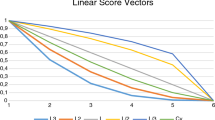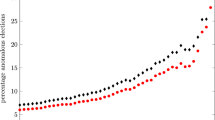Abstract
A striking attribute of instant runoff voting (IRV) is that it is subject to monotonicity failure—that is, getting more (first-preference) votes may result in defeat for a candidate who would otherwise have won and getting fewer votes may result in victory for a candidate who otherwise would have lost. Proponents of IRV have argued that monotonicity failure, while a mathematical possibility, is highly unlikely to occur in practice. This paper specifies the precise conditions under which this phenomenon arises in three-candidate elections and applies them to a number of large simulated data sets in order to get a sense of the likelihood of IRV’s monotonicity problem in varying circumstances. The basic finding is that the problem is significant in many circumstances and very substantial when IRV elections are closely contested by three candidates.



Similar content being viewed by others
Notes
The description here is simplified in that there were other minor candidates and some voters cast ‘truncated’ ballots (that did not rank all candidates). Complete vote tallies may be found at http://rangevoting.org/Burlington.html.
If the number is small, the problem of ties becomes prominent, but there is no standard way to break ties under IRV (or plurality voting). If the number of voters can vary, IRV is subject to additional types of monotonicity problems; see, for example, Norman (2010), Felsenthal and Tideman (2013) and Felsenthal and Nurmi (2016).
Cyclicity follows because UMF implies that the plurality loser beats the IRV winner but DMF implies that it cannot be a Condorcet winner. However, Felsenthal and Tideman (2014) show that, given five or more candidates, cyclicity is not required for 2MF.
However, IRV presents another spoiler problem: which clone candidates wins may depend on whether D enters the election.
Specifically, each sample was generated by drawing the number of first preferences for candidate X from a normal distribution with a mean of 10 million and standard deviation of 1.2 or 2.4 or 3.3 million, subject to the constraint that x ≥ 0, and rounding to the nearest integer. Then the number of such ballots ranking Y second was drawn from a normal distribution with a mean of x/2 and a standard deviation of x/6, subject to the constraint that 0 ≤ x y ≤ x, with Z ranked second in the remaining x z = x − x y ballots. The numbers for the other rankings were determined in like manner.
This measure of election closeness directly ties in with the definition of competitiveness used in Proposition 1 and elsewhere. The percent of first-preference support for the plurality winner minus that for the plurality loser is an alternative measure, which entails no specific threshold for UMF; in figures based on this measure, UMF and DMF both appear gradually (though DMF appears earlier) as closeness increases, but otherwise they are very similar to those presented here.
These data come from Pippa Norris’s Shared Datasets website (http://www.hks.harvard.edu/fs/pnorris/Data/Data.htm).
While this analysis has been restricted to the case of three-candidate elections, it also applies to the penultimate stage of a multi-candidate IRV election in which three candidates survive. This suggests that vulnerability to monotonicity failure is no less frequent, and likely more frequent, in multi-candidate elections.
However, Felsenthal (2012) characterizes non-monotonicity as an ‘especially intolerable’ property for a voting rule.
For example, see the quotations in the introductory Section.
In fact, after the Burlington election local activists examined the IRV ballots with enough care to discover companion profiles that rendered the original profile vulnerable to monotonicity failure. This provoked enough controversy to lead to the enactment of a different voting system, namely ordinary plurality plus runoff—which has the same problem but hides it better.
References
Allard, C. (1996). Estimating the probability of monotonicity failure in a U.K. general election. Voting Matters, 5, 1–7.
Amy, D. (2000). Behind the ballot box: A citizen’s guide to voting systems. Westport, CN: Praeger.
Berg, S., & Lepelley, D. (1993). Note sur le calcul de la probabilité des paradoxes du vote. Mathématiques, Informatique et Sciences Humaines, 121, 33–48.
Bradley, P. (1995). STV and monotonicity: A hands-on assessment. Representation, 33(2), 46–47.
Brams, S. J., & Fishburn, P. (1983). Some logical defects of the single transferable vote. In A. Lijphart & B. Grofman (Eds.), Choosing an electoral system (pp. 147–151). New York: Praeger.
Curtice, J. (2009). Recent history of second preferences. (http://news.bbc.co.uk/nol/shared/spl/hi/uk_politics/10/alternative_vote/alternative_vote_june_09_notes.pdf).
Doron, G., & Kronick, R. (1977). Single transferable vote: An example of a perverse social choice function. American Journal of Political Science, 21(2), 303–311.
Fair Vote (2009). Monotonicity and IRV—why the monotonicity criterion is of little import. (http://archive.fairvote.org/monotonicity/).
Farrell, D. M. (2001). Electoral systems: A comparative introduction. Hampshire: Palgrave.
Felsenthal, D. S. (2012). Review of paradoxes afflicting procedures for electing a single candidate. In D. S. Felsenthal & M. Machover (Eds.), Electoral systems: Paradoxes, assumptions, and procedures (pp. 19–91). Berlin: Springer.
Felsenthal, D. S., & Nurmi, H. (2016). Two types of participation failure under nine voting methods in variable electorates. Public Choice, 168(1-2), 115–135.
Felsenthal, D. S., & Tideman, N. (2013). Varieties of failure of monotonicity and participation under five voting methods. Theory and Decision, 75(1), 59–77.
Felsenthal, D. S., & Tideman, N. (2014). Interacting double monotonicity failure with strategic feasibility under five voting methods. Mathematical Social Science, 67, 57–66.
Fishburn, P., & Brams, S. J. (1983). Paradoxes of preferential voting. Mathematics Magazine, 56, 207–214.
Lepelley, D., Chantreuil, F., & Berg, S. (1996). The likelihood of monotonicity paradoxes in run-off elections. Mathematical Social Sciences, 31, 133–146.
Norman, R. Z. (2010). The relationship between monotonicity failure and the no-show paradox. Paper presented at the 2010 annual meeting of the Public Choice Society, Monterey, CA, March 11–14, 2010.
Ornstein, J. (2010). High prevalence of nonmontonic behavior in simulated 3-candidate STV elections. Paper presented at the annual meeting of the public choice society, Monterey, CA, March 11–14, 2010.
Ornstein, J., & Norman, R. Z. (2014). Frequency of monotonicity failure under instant runoff voting: Estimates based on a spatial model of elections. Public Choice, 161(1), 1–9.
Plassmann, F., & Tideman, T. N. (2014). How frequently do different voting rules encounter voting paradoxes in three-candidate elections? Social Choice and Welfare, 42(1), 31–75.
Poundstone, W. (2008). Gaming the vote: Why elections aren’t fair. New York: Hill and Wang.
Riker, W. H. (1982). Liberalism against populism: A confrontation between the theory of democracy and the theory of social choice. San Francisco: W.W. Freeman.
Ritchie, K., & Gardini, A. (2012). Putting paradoxes into perspective—in defence of the alternative vote. In D. S. Felsenthal & M. Machover (Eds.), Electoral systems: Paradoxes, assumptions, and procedures (pp. 275–303). Berlin: Springer.
Sen, A. K. (1966). A possibility theorem on majority decisions. Econometrica, 34, 491–499.
Smith, J. H. (1973). Aggregation of preferences with variable electorate. Econometrica, 41, 1027–1041.
Smith, W. (2010). Three-candidate instant runoff voting: Master list of paradoxes and their probabilities. Center for Range Voting. http://rangevoting.org/IrvParadoxProbabilities.html.
Straffin, P. D., Jr. (1980). Topics in the theory of voting. Boston: Birkhauser.
Tideman, T. N. (1987). Independence of clones as a criterion for voting rules. Social Choice and Welfare, 4, 185–206.
Acknowledgements
An earlier version of this paper was presented at the Second World Congress of the Public Choice Societies, Miami, March 8–11, 2012. This revision uses more extensive simulations, replaces tables with graphs, and corrects several errors, but it entails no substantial changes in results. The conference version of the paper has been cited in several subsequent works, which are in turn cited here. I thank Robert Z. Norman, Joseph Ornstein, and Dan Felsenthal for helpful comments.
Author information
Authors and Affiliations
Corresponding author
Appendix: Proof of Proposition 1
Appendix: Proof of Proposition 1
Condition 1 requires that n/2 − x > y − z. Substituting (n − y − z) into this expression in place of x, removing parentheses, and simplifying gives
which further simplifies to Condition 1U. Thus z > n/4 puts Z, rather than Y, into the runoff with X under B′.
Condition 2 requires that Z beat X in the runoff under B′. This implies that Z also beats X under B. Therefore, Condition 2U is necessary for UMF, but it needs to be shown that it is also sufficient.
In the event that y x ≥ y − z, all the first-preference ballots that X must gain at Y’s expense to make Y the plurality loser under B′ can come from the y x ballots that would in any case transfer to X in a runoff with Z under B, so Z beats X by the same margin under B′ as under B. If y x < y − z, it is evidently more difficult for Z to beat X under B′ than under B because, to the extent that y − z exceeds y x , Z loses and X gains [(y − z) − y x ] transferred ballots from Y in the runoff. Therefore, it must be that
Suppose to the contrary that
Removing parentheses and rearranging terms, we get
Substituting (n − z) for (x + y) and further simplifying, we get z ≤ n/4, contradicting Condition 1U. Thus, given that Condition 1U holds, it follows that, if Z beats X under B, Z also beats X under B′ and therefore implies UMF.
Rights and permissions
About this article
Cite this article
Miller, N.R. Closeness matters: monotonicity failure in IRV elections with three candidates. Public Choice 173, 91–108 (2017). https://doi.org/10.1007/s11127-017-0465-5
Received:
Accepted:
Published:
Issue Date:
DOI: https://doi.org/10.1007/s11127-017-0465-5




